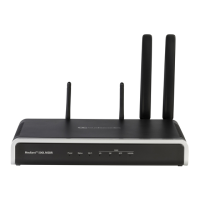User's Manual 476 Document #: LTRT-10466
Mediant 500L MSBR
29.14 Configuring Multi-Line Extensions and
Supplementary Services
The Supplementary Services table lets you configure up to 100 supplementary services for
endpoints connected to the device. These endpoints include analog FXS phones and
Integrated Services Digital Network (ISDN) Basic Rate Interface (BRI) phones.
The table can be used for the following functionalities:
Configuring multiple phone line extension numbers per FXS/BRI port, supporting
point-to-multipoint configuration of several phone numbers per FXS/BRI channel.
Registration of each line extension (endpoint), using a user-defined user ID and
password, to a third-party softswitch for authentication and/or billing. For each line
extension, the device sends a SIP REGISTER to the softswitch, using the global
number in the From/To headers. If authentication is necessary for registration, the
device sends the endpoint’s user ID and password in the SIP MD5 Authorization
header. For viewing registration status, see ''Viewing Registration Status'' on page
700.
Caller ID name per line extension, which is displayed to the called party (if enabled).
Enabling receipt by the line extension of caller ID from incoming calls.
Routing IP-to-Tel calls (including voice and fax) to specific endpoints based on called
line extension number (local number). To enable this functionality, in the Trunk Group
Settings table, set the 'Channel Select Mode' field to Select Trunk by
Supplementary Services Table for the Trunk Group to which the FXS/BRI port
belongs (see ''Configuring Hunt Group Settings'' on page
375).
Mapping local numbers (line extension number) with global phone numbers (E.164).
The endpoint can be configured with two numbers – local and global. The local
number represents the endpoint’s line extension number (e.g., PBX extension
number); the global number represents the corresponding E.164 number used for the
IP side in the SIP message:
• IP-to-Tel calls: Maps the called global number in the user part of the SIP
Request-URI in the incoming SIP message to the local number sent to the Tel
side. For example, the device receives an incoming IP call with a destination
(called) that is a global number 638002 and then sends the call to the Tel side
with the destination number manipulated to the corresponding local number of
402.
• Tel-to-IP Calls: Maps the calling (source) local number of the Tel side to the
global number sent to the IP side (in the From and To headers of the outgoing
SIP message). For example, if the device receives a Tel call from line extension
local number 402, it changes this calling number to 638002 and then sends the
call to the IP side with this calling number. This functionality in effect, validates
the calling number.
Notes:
• If you have configured regular Tel-to-IP or IP-to-Tel manipulation rules (see
''Configuring Source/Destination Number Manipulation Rules'' on page 381), the
device applies them before applying the local-global mapping rules configured in
the table.
• To allow the end-user to hear a dial tone when picking up the BRI phone, it is
recommended to set the Progress Indicator in the Setup Ack bit (0x10000=65536).
Therefore, the recommended value is 0x10000 + 0 x1000 = 65536 + 4096 =
69632 (i.e., set the ISDNInCallsBehavior parameter to 69632).

